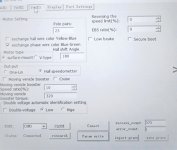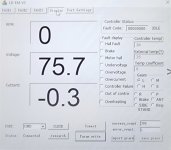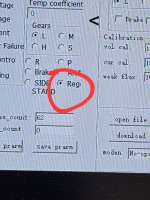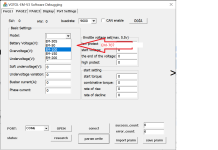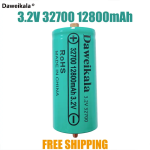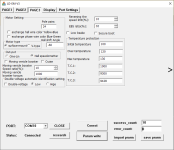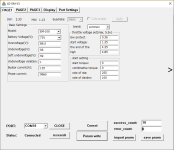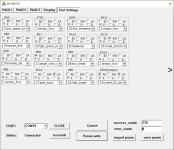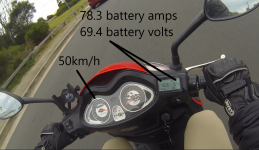please change EBS value instead od decline value which is decreasing of acceleration.hi everyone, i'm new member here..
can somebody help me? i have e bike 800 watt, 60v with 25 ah lifepo4 battery
using votol em50s.
i have activated throttle release regenerative brake, the problem is, after change "rate of decline " value on page 1, the regen feels the same, whether it is 10 or 150. is there another setting should i activate or maybe another problem?
thank you.
UPDATE : Problem solved, by changing the EBS ratio value, usually only rate of decline value is enough.but now seems like i should also change ebs ratio too.
You are using an out of date browser. It may not display this or other websites correctly.
You should upgrade or use an alternative browser.
You should upgrade or use an alternative browser.
Votol EM-100 & EM-150 controllers
- Thread starter Stefanj.
- Start date
Can you please send me bin file for upgradeBin sent by mail
Enviado desde mi SM-N960U mediante Tapatalk
yes, it's work by changing EBS value, i set it to 15% now, 25% for aggressive slowdown. but i'm not sure, is it save for long down hill ride with 25% ?please change EBS value instead od decline value which is decreasing of acceleration.
Hello! I'm trying to setup my Votol EM50.
On the 3rd tab, I set a checkbox to replace the phases blue with green and the hall sensor manually changed mechanically yellow with green and set the Hall angle value to 180°. This made it possible to achieve the smoothest and quietest operation of the motor.
In addition, at some speeds, the engine vibrates.
Problem:
I can't disable regen.
At the slightest rotation of the wheel, regeneration occurs. This occurs also on high brake.
Regeneration occurs even when turning the wheel manually at a very low speed. There is a faint sound from the engine.
When the ignition is off, this sound is not present.
Please help me to check the correctness of the settings and explain to me what each one is responsible for.
My wheel: https://www.amazon.ca/Electric-Bicycle-Conversion-Precise-Processing/dp/B0B6RW2JN1
On the 3rd tab, I set a checkbox to replace the phases blue with green and the hall sensor manually changed mechanically yellow with green and set the Hall angle value to 180°. This made it possible to achieve the smoothest and quietest operation of the motor.
In addition, at some speeds, the engine vibrates.
Problem:
I can't disable regen.
At the slightest rotation of the wheel, regeneration occurs. This occurs also on high brake.
Regeneration occurs even when turning the wheel manually at a very low speed. There is a faint sound from the engine.
When the ignition is off, this sound is not present.
Please help me to check the correctness of the settings and explain to me what each one is responsible for.
My wheel: https://www.amazon.ca/Electric-Bicycle-Conversion-Precise-Processing/dp/B0B6RW2JN1
Attachments
erfwyl
10 µW
- Joined
- Dec 25, 2022
- Messages
- 6
Votol EM-70 controller - I can't find any VOTOL-EM Software Debugging that provides an option for EM-70. Under model setting in VOTOL-EM-V3 Software Debuggingthe dropdown menu options are EM30S, EM50, EM100, EM150, EM200
There are a couple of sellers on Aliexpress in whose demo snaphots of the VOTOL-EM GUI it says EM-100, so I'm not even sure there is specific EM70 interface.
Does anyone have experience in what to use for the EM70 - is the EM100 OK?
At this stage all I am trying to do is find the spec parameters for this old and likely damaged EM 70 so that I can transfer these to the new EM-150 I'd like to replace it with. My challenge is that the manufacturer/supplier of my etrike has been unable to provide any specs on the 72V motor they supplied.
I'm more than happy to record any progress on here in case that helps anyone else.
There are a couple of sellers on Aliexpress in whose demo snaphots of the VOTOL-EM GUI it says EM-100, so I'm not even sure there is specific EM70 interface.
Does anyone have experience in what to use for the EM70 - is the EM100 OK?
At this stage all I am trying to do is find the spec parameters for this old and likely damaged EM 70 so that I can transfer these to the new EM-150 I'd like to replace it with. My challenge is that the manufacturer/supplier of my etrike has been unable to provide any specs on the 72V motor they supplied.
I'm more than happy to record any progress on here in case that helps anyone else.
If you use the Votol software and set it for other models, does it read anything consistent from the EM70 anyway? If there are any consistently-read parameters that are different from the defaults the software would show without reading a controller, they are probably the settings from the EM70.
Parameters from one controller might have different scales or ranges in another, depending on the value they are intended to represent, how the controller stores them, and how the software is written to display them. That's one reason that you would want to try to read it as multiple different controllers, so that anything that changes from one to the other can be eliminated as usable data.
However, Votol would have to tell you for sure, without testing these things.
Parameters from one controller might have different scales or ranges in another, depending on the value they are intended to represent, how the controller stores them, and how the software is written to display them. That's one reason that you would want to try to read it as multiple different controllers, so that anything that changes from one to the other can be eliminated as usable data.
However, Votol would have to tell you for sure, without testing these things.
erfwyl
10 µW
- Joined
- Dec 25, 2022
- Messages
- 6
Hi Amberwolf, thanks very much for your reply. Please forgive my noob-ness (very steep learning curve). I have reread your response a number of times and I think you're saying that unless Votol instruct otherwise, I'm wasting my time trying to use the VOTOL-EM-V3 Software Debugging package? Or is it precisely the converse you are saying - Ie they try to keep things consistent as much as possible for simplicity and ubiquity across the models?If you use the Votol software and set it for other models, does it read anything consistent from the EM70 anyway? If there are any consistently-read parameters that are different from the defaults the software would show without reading a controller, they are probably the settings from the EM70.
Parameters from one controller might have different scales or ranges in another, depending on the value they are intended to represent, how the controller stores them, and how the software is written to display them. That's one reason that you would want to try to read it as multiple different controllers, so that anything that changes from one to the other can be eliminated as usable data.
However, Votol would have to tell you for sure, without testing these things.
I have sent Votol an email and will be sure to share my learnings here if I receive any form of meaningful response.
Let me rephrase my question so I may understand the answer a little more clearly. If I had an EM100 controller and tried to hook into that via USB interface to save the configuration then this would be possible right? The voltage settings (for example) for that motor would then presumably be the same, even in a more powerful controller like the EM150 if I set that up to those values? Or am I simplifying too much and just displaying my clear ignorance of emotors and controllers with this assumption?
We have no good way of knowing for sure if Votol used different setting data in each controller version, or how they implemented pretty much anything in it.  If the data is different it may be read differently by the setup program if you "lie" to the setup program and tell it it is connected to a different version. Then if you use that data in some other controller, it may not work at all the same as it did in the first one.
If the data is different it may be read differently by the setup program if you "lie" to the setup program and tell it it is connected to a different version. Then if you use that data in some other controller, it may not work at all the same as it did in the first one.
You can try testing it:
--Connect the setup program to your em70, and set the setup program to the first version it has in the list, then try to read the EM70 settings. If it reads them, note them all down or screenshot, etc.
--Connect the setup program to your em70, and set the setup program to the next version it has in the list, then try to read the EM70 settings. If it reads them, note them all down or screenshot, etc.
--Repeat until you have read the settings using all available versions it has in it's list and noted them all down.
--Compare all the settings it read between versions.
--If all readings are identical, and are *not* just the default readings the setup program would show if you hadn't connected a controller to it and read it out, then it probably read the settings correctly from the controller.
If they are just the defaults then it probably means the controller couldn't be read by the program.
If they are not identical between each version's readout, then it means it translates teh data it gets from the controller differently based on which controller is selected, and that means that since the 70 isn't listed, it probably isn't showing the data correctly to you, and you probably can't trust the values it shows you.
You can try testing it:
--Connect the setup program to your em70, and set the setup program to the first version it has in the list, then try to read the EM70 settings. If it reads them, note them all down or screenshot, etc.
--Connect the setup program to your em70, and set the setup program to the next version it has in the list, then try to read the EM70 settings. If it reads them, note them all down or screenshot, etc.
--Repeat until you have read the settings using all available versions it has in it's list and noted them all down.
--Compare all the settings it read between versions.
--If all readings are identical, and are *not* just the default readings the setup program would show if you hadn't connected a controller to it and read it out, then it probably read the settings correctly from the controller.
If they are just the defaults then it probably means the controller couldn't be read by the program.
If they are not identical between each version's readout, then it means it translates teh data it gets from the controller differently based on which controller is selected, and that means that since the 70 isn't listed, it probably isn't showing the data correctly to you, and you probably can't trust the values it shows you.
Mott
1 µW
Hello, I’m trying to set up a Voltol em150 with a yuma hub drive 4000w . I keep getting a motor hall fault . The fault code is 0000008 . I swapped this onto an existing 500w Ebike with a vector controller. Thanks for any advice I can get.
What conditions exist at the moment of the error?
Did it ever work correctly, or has it had the same problem since first power on?
Has it has any other problems, either before or after swapping out the controller?
Have you replaced your battery from the 500w system for one that is capable of powering the 4000w system? Or was it already designed to run a system eight times more powerful than the original?
What setup parameters have you gone thru to configure the controller to your specific motor, battery, and riding style/requirements/conditions?
Did it ever work correctly, or has it had the same problem since first power on?
Has it has any other problems, either before or after swapping out the controller?
Have you replaced your battery from the 500w system for one that is capable of powering the 4000w system? Or was it already designed to run a system eight times more powerful than the original?
What setup parameters have you gone thru to configure the controller to your specific motor, battery, and riding style/requirements/conditions?
Hello,Regarding the screenshots and readouts:
LFP has a very flat discharge curve, so a tiny difference in voltage between cells means a significant capacity difference (or rather, difference in SoC, state of charge).
I attached a graph of a random LFP cell off the Lygte.info.dk testing site, original here:
zoomed in and edited to show some finer voltage gradations; if you follow those across the chart you'll see how the cell voltage drops as capacity decreases (I think the actual capacity numbers are cut off, but they are about 250mAh per vertical line, for an 1800mAh cell, totally empty at far right as the curves all reach the bottom at 2.0v
You can put lines on there for your cell voltages to see the possible difference in capacity percentage between the ones with different voltages (you might have to zoom it in farther).
Basically what I'm trying to show is that your cells are not perfectly balanced (even if they match voltages at full charge), they don't match each other in state of charge / capacity (probably internal resistance too), and so they are discharging at different rates, and will also sag at different rates and amounts. The ones with the lowest voltage have the lowest charge amount and will probably sag more under less load than the others. It's likely that this sort of problem is causing your system issue, but you'll have to test in a way that you can see this happening to be sure, or repair the battery so it is operating correctly and then retest the system.
Regarding the controller setup screenshot:
I see an HVC (overvoltage) of 89.5v, which is high for this pack; the pack should be full at 87.6v or less.
THe LVC (undervoltage) is 63v, whihc would be way too low--the cells would be beyond empty, and would be damaged, if the controller was the only cut off (like if the BMS failed to shutdown due to FET failure or software problems), at that voltage. I'd set that to something like 69.6 or even 72v.
The soft undervoltage, where the controller begins to limit power usage to minimize load on the nearly-empty battery, at 66v is also too low; it wouldn't cause damage but it won't give the system any leeway to protect the cells. I'd set that to something like 72v or higher.
I appreciate the great info, i have been trying to hunt down damage cells in my pack. I purchased an internal resistance tester the YR1035. What i don’t understand is that it shows a resistance of about 10-12 mOhms on the brand new cells i bought and only 5-7 mOhms on the ones i suspect as damaged. Why would bad cells have less resistance? They are all at about the same voltage.
Thank you!
Paulflieg, what is the three pin break wire on the votol wiring harness for?The votol neither switches on the light nor the brake light. This is usually done with a 12v voltage converter and the brake lever switches.
Mott
1 µW
Hello, thanksWhat conditions exist at the moment of the error?
Did it ever work correctly, or has it had the same problem since first power on?
Has it has any other problems, either before or after swapping out the controller?
Have you replaced your battery from the 500w system for one that is capable of powering the 4000w system? Or was it already designed to run a system eight times more powerful than the original?
What setup parameters have you gone thru to configure the controller to your specific motor, battery, and riding style/requirements/conditions?
The new motor/ controller has never worked, everything is fine when I switched back to the original motor/ controller.
I using the original gel acid 20 ah 72v battery setup. I tried to configure ( download) now I have no fault but now doesn’t show any voltage or rpm . The dash is now not showing gear selection either.
I only ride about 6 km round trip,( shorter if I could climb hills) don’t plan on exceeding 60kph . I expect the batteries to drain quicker. I have a lithium 72v 50ah battery with a 200bpm , but don’t want to modify the bike frame for it if it’s not going to work.
Mott
1 µW
Hello, thanks
The new motor/ controller has never worked, everything is fine when I switched back to the original motor/ controller.
I using the original gel acid 20 ah 72v battery setup. I tried to configure ( download) now I have no fault but now doesn’t show any voltage or rpm . The dash is now not showing gear selection either.
I only ride about 6 km round trip,( shorter if I could climb hills) don’t plan on exceeding 60kph . I expect the batteries to drain quicker. I have a lithium 72v 50ah battery with a 200bpm , but don’t want to modify the bike frame for it if it’s not going to work.


Mott
1 µW
I didn’t get pictures when the fault was present
erfwyl
10 µW
- Joined
- Dec 25, 2022
- Messages
- 6
I asked this question of the good folk at Votol.net:We have no good way of knowing for sure if Votol used different setting data in each controller version, or how they implemented pretty much anything in it.If the data is different it may be read differently by the setup program if you "lie" to the setup program and tell it it is connected to a different version. Then if you use that data in some other controller, it may not work at all the same as it did in the first one.
You can try testing it:
--Connect the setup program to your em70, and set the setup program to the first version it has in the list, then try to read the EM70 settings. If it reads them, note them all down or screenshot, etc.
--Connect the setup program to your em70, and set the setup program to the next version it has in the list, then try to read the EM70 settings. If it reads them, note them all down or screenshot, etc.
--Repeat until you have read the settings using all available versions it has in it's list and noted them all down.
--Compare all the settings it read between versions.
--If all readings are identical, and are *not* just the default readings the setup program would show if you hadn't connected a controller to it and read it out, then it probably read the settings correctly from the controller.
If they are just the defaults then it probably means the controller couldn't be read by the program.
If they are not identical between each version's readout, then it means it translates teh data it gets from the controller differently based on which controller is selected, and that means that since the 70 isn't listed, it probably isn't showing the data correctly to you, and you probably can't trust the values it shows you.
The reply from them is:
yes, you can use EM100 or any one. this option doesnt mean anything. you can also take reference from bellowing link:
Support - Zhejiang Huaqu International Trade Co., Ltd (varcheaemobility.com)
The link leads to a bunch of very helpful pdf support documents including votol error codes, manual etc.
The software compatibility was also independently verified by James Chiang of Dunn Controllers via this Youtube video question and response in comments (I don't know if they are a reseller, manufacture using that architecture under their brandname or if their product is somehow not identical).
I hope someone finds this useful
Meanwhile, I'm going to have to wait until my NO CAN USB cable arrives, turns out I need that for the EM70 and a CAN USB Cable for the EM150/S
Cheers,
Erfwyl
Last edited:
Are they identical brand and model of cell? If not, they may have very different characteristics from your originals; you'd have to look at the manufacturer spec sheets for each one to see what they should be (not what the seller says, but the manufacturer).Hello,
I appreciate the great info, i have been trying to hunt down damage cells in my pack. I purchased an internal resistance tester the YR1035. What i don’t understand is that it shows a resistance of about 10-12 mOhms on the brand new cells i bought and only 5-7 mOhms on the ones i suspect as damaged. Why would bad cells have less resistance? They are all at about the same voltage.
If they are identical brand and model, then it sounds like they may either not be new, or are a worse quality batch than the ones you already had, assuming that the difference you see in readings is consistent every time you disconnect and reconnect the leads and measure each one.
If the readings are inconsistent, then there is probably a connection issue between tester and cell causing these differences.
However...if the cells you have are big high capacity pouch or prismatic cells, and not something tiny like 18650, then even 5milliohms is a pretty awful cell. Even the ancient (>13year-old-design) EIG 20Ah pouch cells I have are better than that, at less than 3milliohms per cell. :/
If your cells are 18650s, then good ones like some of the samsungs, etc., could be as much as 25milliohm per cell. lygte-info.dk has specs and actual cell testing info for a lot of these small cells, useful for comparison with your testing.
Amber wolf,Are they identical brand and model of cell? If not, they may have very different characteristics from your originals; you'd have to look at the manufacturer spec sheets for each one to see what they should be (not what the seller says, but the manufacturer).
If they are identical brand and model, then it sounds like they may either not be new, or are a worse quality batch than the ones you already had, assuming that the difference you see in readings is consistent every time you disconnect and reconnect the leads and measure each one.
If the readings are inconsistent, then there is probably a connection issue between tester and cell causing these differences.
However...if the cells you have are big high capacity pouch or prismatic cells, and not something tiny like 18650, then even 5milliohms is a pretty awful cell. Even the ancient (>13year-old-design) EIG 20Ah pouch cells I have are better than that, at less than 3milliohms per cell. :/
If your cells are 18650s, then good ones like some of the samsungs, etc., could be as much as 25milliohm per cell. lygte-info.dk has specs and actual cell testing info for a lot of these small cells, useful for comparison with your testing.
thank you for the reply, below is a picture and description of the batteries that I’m using. They claim an impressive 12 amp hours, and the resistance is stated as 6-7mOhms. That is consistent with the readings i’m getting on the old cells. You mentioned that the new batch i have reading 10-12mOhms could be bad. the mystery for me is that when I replaced the suspected bad cells with the new ones, showing higher resistance by nearly double the issue with those cells was resolved.
Now i am showing that another set of batteries in a different cell is running out long before the others. I am playing whack a mole, i know and i’m ok with that, but i can’t do it blind with readings that tell me nothing about the condition of a given battery.
How could a battery be falling way before all the others and show better resistance than the ones that are out performing it? Also, what is the result of having a failing battery which has a lower capacity in a parallel set of three batteries? I assume it effectively makes that cell a 2p not 3p but when i go test them all three batteries have low resistance and i can’t tell why that cell is under performing.
They are all these same batteries bought from the same seller but at different times. i guess it could be a bad batch but when i is the new batteries it fixes the problem.
Thank you for your ideas.
You mentioned before pulling these questions into a build thread. I don’t have one, would it be possible to pull all my posts into a new thread?
Daweikala New 32700 12800mAh 3.2V lifepo4 Rechargeable Battery Professional Lithium Iron Phosphate Power Battery
Battery parameters:
Condition: New
Model: 32700 LiFePo4 battery
Size: diameter 32mm high 70mm
Nominal voltage: 3.2V (fully charged voltage of 3.65V, the cut-off voltage 2.5V)
Resistance: 6-7 milliohms
Maximum continuous discharge rate: 8C
Rated Capacity: 12800mAh
Attachments
Amber wolf,
thank you for the reply, below is a picture and description of the batteries that I’m using. They claim an impressive 12 amp hours, and the resistance is stated as 6-7mOhms. That is consistent with the readings i’m getting on the old cells. You mentioned that the new batch i have reading 10-12mOhms could be bad. the mystery for me is that when I replaced the suspected bad cells with the new ones, showing higher resistance by nearly double the issue with those cells was resolved.
I'm not sure what the last sentence means; the wording is confusing.
I am playing whack a mole, i know and i’m ok with that, but i can’t do it blind with readings that tell me nothing about the condition of a given battery.
Then you'll need to test the properties of the cells to find out what they are.
What is the test setup? Is the resistance identical every time you test it, and are the test conditions for every cell identical? (same voltage / state of charge, temperature, connection method, etc)How could a battery be falling way before all the others and show better resistance than the ones that are out performing it?
If it's voltage is lower than the others, it's resistance could be lower, depending on where each is in the SoC curve.
Either way, it's capacity is almost certainly lower, which *usually* means for otherwise identical cells that its' resistance would be higher.
If a cell is lower capacity, the group as a whole is lower capacity, because it is calculated as Ah-per-cell x number-of-parallel-cells.Also, what is the result of having a failing battery which has a lower capacity in a parallel set of three batteries? I assume it effectively makes that cell a 2p not 3p but when i go test them all three batteries have low resistance and i can’t tell why that cell is under performing.
If you mean underperforming in some other way, you'll need to define that.
I think some words or characters are missing, because that last sentence doesn't make sense.They are all these same batteries bought from the same seller but at different times. i guess it could be a bad batch but when i is the new batteries it fixes the problem.
For the first sentence, if they are different batches of cells they can vary in (any) properties and so perform differently in the pack together.
To have a well-performing pack you'd need to test all the cells and match the properties of them all as closely as possible.
If you can't match individual cells, but you use multiple parallel cells in each group, you can mix and match to get as close as possible to the same *average* properties between every group.
Sure. I can move them all there and title it whatever you want (and you can edit the first post of it at any time to change the title if you like).You mentioned before pulling these questions into a build thread. I don’t have one, would it be possible to pull all my posts into a new thread?
What vehicle/etc is it for? (that determines which build subforum it would go in--ebikes, motorcycles, scooters, watercraft, aircraft, etc).
FWIW, this randomly found video shows these are not very good cells, and that they may be lying about their capacity by more than 2x. I did not watch the video, just dragged the slider forward to the end of the test where capacity is found to be only 5900mAh, not even half of the rated capacity of 12800mAh.Daweikala New 32700 12800mAh 3.2V lifepo4 Rechargeable Battery Professional Lithium Iron Phosphate Power Battery
I'm not sure what the realistic max capacity of that size of cell is, but I suspect it's under 7Ah, and that any numbers above that are magically inflated by marketing. :/
You'd have to test all of your cells to verify what their actual properties are.
Last edited:
hey all, I'm looking for help getting my new em80gtsp going. I have a cyclone 3k motor and a 66.6v 8ah lipo battery. I bought it from siaecosys so I used the software from there site and self learn mode from same place. after completing self learning, the hall shift angle changes to what it is in pic (this I think is root cause of problem). I have tried this several times and it has been 3, 2, and now 1? anyway once I switch back the port to "17 park input" and open the park gear circuit rewrite param and reset power the motor does not spin at all. I have tried going back to default parameters and doing a manual phase line match ,with both-60 and -180 deg hall angle, like old school and still nothing happens. I have checked the voltage on from the throttle and it behaves normally. I need help sia is not responding to my emails. 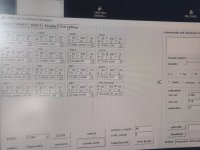
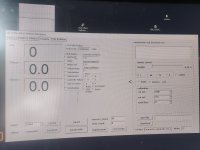


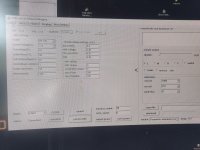





Last edited:
Hello,hey all, I'm looking for help getting my new em80gtsp going. I have a cyclone 3k motor and a 66.6v 8ah lipo battery. I bought it from siaecosys so I used the software from there site and self learn mode from same place. after completing self learning, the hall shift angle changes to what it is in pic (this I think is root cause of problem). I have tried this several times and it has been 3, 2, and now 1? anyway once I switch back the port to "17 park input" and open the park gear circuit rewrite param and reset power the motor does not spin at all. I have tried going back to default parameters and doing a manual phase line match ,with both-60 and -180 deg hall angle, like old school and still nothing happens. I have checked the voltage on from the throttle and it behaves normally. I need help sia is not responding to my emails. View attachment 335778View attachment 335779View attachment 335780View attachment 335781View attachment 335782
I don't know that motor, but those shift angles sounds weird. Does it have v-type magnets?. Park input is LA not SW. You can also try to disable it F -> D
spinningmagnets
100 TW
I don't know if this has been posted yet, but this video speaks very highly of the Votol controllers as far as they physical components.
Votol EM-150 Overview
Aaand here is the article I wrote about this youtube

Votol EM-150 Overview
Aaand here is the article I wrote about this youtube

Votol controllers for hot rod builds
I have to confess that I am no expert when it comes to controllers, and when I find someone who has a lot of experience and is honest about the benefits and drawbacks of any given model of controll…
www.electricbike.com
Last edited:
Hi everyone,
I'm having trouble stabilising the controllers output to give predictable power delivery when applying full throttle.
Sometimes full throttle immediately deliverers 230 battery amps, other times 40 battery amps, sometimes it ramps up and other times it ramps down. This is especially a problem when going up an incline on a street where there is no shoulder and the limited amps mean you slow down will full throttle, all the way to about 5kmh. The only way to reset this is to completely stop.
Motor: YM Motor 3000W 40H 13" hub wheel
Battery: 72v 65ah
Bike: TailG8 scooter (Above 1500w – TAILG) 125kg all up weight
rider: 95kg
I've attached the settings screenshots and a screenshot from the videos to show the important info.
I have made some video recordings of a ride on the scooter. These demonstrate that the full throttle doesn't give a predictable amp output, sometimes it immediately gives over 200 battery amps, and other times it only gives 40 and reduces all the way down to 10battery amps.
Description of video: One clip with voiceover 1
Single unedited clip showing alternating between applying full power, and the battery amps draw. Also shows that after applying regeneration braking and then full power, it immediately gives 200 battery amps.
Description of video: selection of short clips
Many small clips showing when full throttle is applied. Sometimes it gives over 200 amps, sometimes only 40amps.
I'd really appreciate any suggestions that you can make.
I really appreciate everyone's help or suggestions.
I'm having trouble stabilising the controllers output to give predictable power delivery when applying full throttle.
Sometimes full throttle immediately deliverers 230 battery amps, other times 40 battery amps, sometimes it ramps up and other times it ramps down. This is especially a problem when going up an incline on a street where there is no shoulder and the limited amps mean you slow down will full throttle, all the way to about 5kmh. The only way to reset this is to completely stop.
Motor: YM Motor 3000W 40H 13" hub wheel
Battery: 72v 65ah
Bike: TailG8 scooter (Above 1500w – TAILG) 125kg all up weight
rider: 95kg
I've attached the settings screenshots and a screenshot from the videos to show the important info.
I have made some video recordings of a ride on the scooter. These demonstrate that the full throttle doesn't give a predictable amp output, sometimes it immediately gives over 200 battery amps, and other times it only gives 40 and reduces all the way down to 10battery amps.
Description of video: One clip with voiceover 1
Description of video: selection of short clips
I'd really appreciate any suggestions that you can make.
I really appreciate everyone's help or suggestions.
Attachments
Thunder_blade
10 mW
- Joined
- Aug 12, 2019
- Messages
- 31
Hello people, i am finding work config for surron motor on votol controller, no meter 100,150 or ever 200. just for lookin for parameters of motor, thnx.
Similar threads
- Replies
- 13
- Views
- 4,059
- Replies
- 15
- Views
- 10,100




